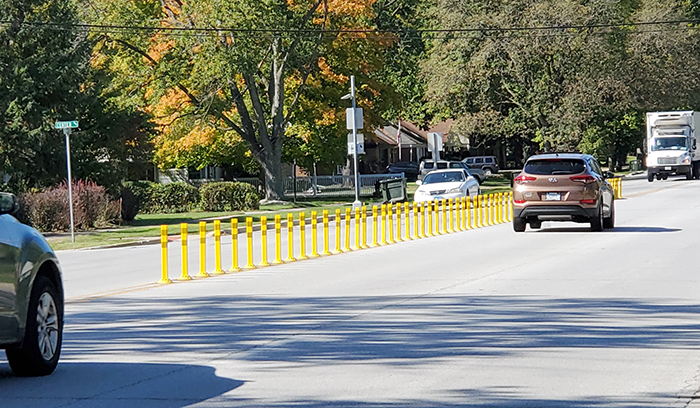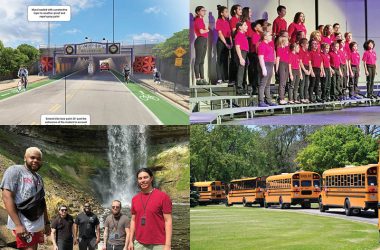In July, when a student-athlete died in a car crash on 183rd Street in Homewood, residents collectively mourned.
Dominique Wood, 19, was killed when 21-year-old Lindsey Anderson, traveling west on 183rd Street, allegedly crashed his Porsche into Wood’s Buick, at the time headed northbound on Center Avenue.
The Suburban Major Accident Reconstruction Team determined Anderson was going 66 mph at the time of the crash.
The Merrillville, Ind., teen’s death also reinvigorated a local movement for action to reduce speeding and crashes along 183rd Street.
At the time, Homewood residents offered plenty of suggestions to make the thoroughfare safer, including traffic signals and signs, speed cameras, intensified enforcement and more.
Signs started popping up along 183rd Street entreating drivers to “SLOW DOWN” or reminding them “30 ≠ 45.”
In response to the outcry after Wood’s death, the village installed a set of fluorescent delineator posts along the center line on 183rd Street at Center Avenue to prevent left turns from 183rd street onto north or southbound Center and to prevent traffic on Center from crossing 183rd.
Almost immediately after the posts were installed, residents reported on social media watching drivers circumvent the barriers, making U-turns around them on 183rd.
Study of a busy stretch
A frustrated public — especially residents who live along 183rd Street — wonder what other measures the village can take to encourage and enforce safer driving.
With 17,000 cars traversing the east-west stretch between Halsted Street and Kedzie Avenue every day, the solution to improve traffic safety is not so simple, said John Schaefer, director of Homewood Public Works.
Schaefer said the village is hiring a company to conduct a traffic study that will collect statistics and provide observations about vehicle travel in town, as well as offer suggestions for potential upgrades and adjustments.
The study will provide empirical evidence and professional feedback that village officials can use to decide what changes to implement. It’s a better way to improve traffic safety than to use casual observations, Schaefer said, and that includes his own.
“Some of the areas people think are more dangerous, they’re not. It public perception,” Schaefer said.
He provided police data on crashes between January 2006 and October 2020. The data divide 183rd Street by major thoroughfares. By far, the greatest number of crashes — 1,281 — occurred between Dixie and Governors Highways.
‘Doing the old cut-through’
While the study reports crashes along only one street, it will consider the issues of speeding and traffic throughout Homewood. This includes side streets, smaller north-south roads that many drivers use to avoid traffic on main roads.
“You get people doing the old cut-through. ‘It’s 5 o’clock and I’m trying to get home, so I’m going to shoot down Willow Road and go 500 mph,’” Schaefer said. “If people can find a shortcut to get around traffic, they’ll take it.”
Transportation specialist Joe Schwieterman of Flossmoor is a professor at DePaul University and director of the school’s Chaddick Institute for Metropolitan Development.
Schwieterman said it’s not surprising that drivers find ways to avoid major local thoroughfares such as Halsted and 183rd Streets by using neighborhood roads.
“The stoplight at 183rd and Halsted can be a logjam, so people find creative ways to avoid it, throwing safety to the wind,” Schwieterman said. “It gets tricky at Halsted with the left turn lane; the light isn’t long enough. People get impatient and cut through quiet residential streets.”
GPS websites and phone apps have changed the way people drive, he said, sometimes acting as their own “worst enemy,” because they funnel too-large volumes of traffic through inappropriate places.
For similar reasons, Schaefer said they must consider traffic pattern data in deciding how to alter roads, to be sure the changes don’t simply shift the problem somewhere else.
“If you start changing the volume down the road, those cars are going to go somewhere,” Schaefer said.
For example, if the village narrowed a section of 183rd Street to two lanes, impatient drivers headed on an east-west route would shift to Ridge Road or 187th Street, creating greater potential for issues on those roads.
Trying to predict traffic after COVID
Homewood officials face a strange obstacle in this traffic study. The COVID-19 pandemic completely altered residents’ lifestyles. School and work are done from home. Events and extracurriculars aren’t happening. Restaurants are shuttered.
With no clear picture of when and how life could return to a normal routine, Schaefer said future traffic patterns remain uncertain.
Though students will eventually return to schools, allowing for analysis of traffic flow at peak times, COVID quarantine may have permanently altered the way Homewood residents work, shop and dine.
If the past year is any indication, traffic seems to be shifting, Schaefer said.
“I’ve noticed especially in the last 12 months, people are driving much more erratically,” he said.
As traffic patterns shift, Schwieterman said we can expect the roads to get more risky. While morning and evening rush hours may ease up in the long haul, traffic could become denser at other times as people are more likely to run errands during the day.
“As more people work from home and conduct business out of their home, we’ll see new traffic patterns that will create risk,” he said.
How enforcement fits in
Overall, three major factors affect people’s driving habits. First, road designs blatantly and implicitly instruct drivers on the safest ways to proceed. Secondly, self-monitoring and self-regulation reign in drivers’ impulses with fear and logic.
Finally, drivers are controlled by road rules and laws, and the enforcement of them. Noncompliant drivers risk getting pulled over and ticketed or even arrested by police.
Some outcries on social media have asked Homewood police to step up enforcement of traffic laws, especially speeding. The Chronicle reached out to Homewood Police Chief Bill Alcott with the following question:
“What do you want the public to know about how much time officers or the department can devote to traffic enforcement vs. the other jobs you’re tasked with?”
Acting as spokeswoman for Alcott and Homewood PD, Deputy Chief Denise McGrath responded with the following statement:
“Officers conduct traffic enforcement, neighborhood patrols and business patrols on a regular basis during the course of their shift, when not handling calls for service.”
McGrath did not reply to requests for additional details.
Schaefer defended the police department, and said traffic enforcement is only a small portion of officers’ jobs. He encouraged people to take more personal responsibility for safe driving.
“You’re seeing a whole change in the way people drive. We’re getting away from being courteous drivers. It’s hard to curtail that. The police can’t be everywhere all the time,” Schaefer said. “The biggest thing is abiding by the law. If the speed limit says 30, it’s not 45. It’s not 55.”
Schweiterman agreed that policing cannot, and should not, alone mitigate the problem of unsafe driving. He lauded Homewood’s first step of putting up the lane divider posts, and said similar tools can help improve traffic safety.
“What Homewood did, we need to see more proactive steps like that to calm traffic. No one tool can solve it,” Schweiterman said.
Drivers speed more now than before
It’s not your imagination, people drive faster these days. Schweiterman said data shows an uptick in drivers’ overall speed, for a few reasons: Fuel efficient cars go faster; cars are quieter so speeding isn’t as loud; high performance braking allows for quicker stops; devices distract a driver.
It’s tempting to suggest that speed cameras, snapping a photo when a passing car exceeds the speed limit, could help reduce excessive speeding in Homewood.
However, Illinois law only allows the use of speed cameras in municipalities with populations of 1 million or more, and only near construction zones, schools and certain park district facilities.



